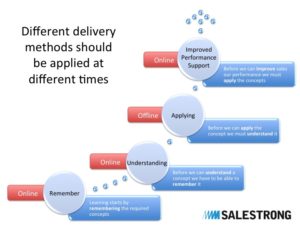What is Sales Training? Ask fifty different consultants or trainers and you will get 50 different responses. No question.
In response to this very question, Team Salestrong took the opportunity to detail 10 types of Sales Training exercises that should be used in all Sales Training courses. If you are a Sales Manager, L&D or designing or evaluating a sales training course, consider this is a handy checklist to ensure all the different types of exercise are in place to ensure success.
Incorporating Sales Training Exercises
When designing Salestrong Sales Training courses, we have a library of Sales Training Exercises to choose from. Sales people are typically active learners and are always keen to avoid theory, so we always ensure that we include as many interactive and experiential sales training exercises as we can. From this library we have created a list of types of different sales training exercises that combine to ensure our courses are successful.
The Different Types of Sales Training Exercises
From the many sales training exercises that exist, we’ve classified them into 10 groupings that are essential for an effective sales training course:
- Breaking the ice
- Energising
- Team building
- Contracting
- Change management
- Highlighting sales skills gaps and feeding back
- Demonstrating best practice
- Moving through the learning process
- Moving the sales people from knowledge to application
- Observing and measuring progress
Breaking the Ice
Icebreakers are discussions or activities used to help participants relax and create a positive group atmosphere. People learn best when they are at ease and when social barriers are lowered, so creating that tone at the start of a session is essential. Icebreakers are also great for learning the names and roles of people as well as personal and professional information. You could argue that best practice is not allowing ice to form in the first place! But you need these in your kit bag in case it does.
Energising
Sales people are typically active learners and will suffer in sessions where there is a large volume of theory. Energisers are short exercises that get people moving and out of their seats to help them remain involved, energised and active throughout the learning experience. The real key with energisers is to tie them into the learning. Random and irrelevant ones can be counter productive and leave people feeling manipulated.
Team Building
Team building exercises are particularly important on sales training courses, as today selling is a team sport in three important areas:
- Communication: no sales person should work alone. They should ensure that communication in the team is working to help speed up the sales cycle.
- Influence: using your whole business as your sales team can influence the customer if, for example, you get your C-level colleagues to reach out directly to C-level people at the prospect. For example your FD makes a call to the prospect’s FD.
- Creativity: customers and prospects are looking for insights. You’re far more likely to get more insights into a sale with a larger and more diverse team behind you.
Contracting
Contracting with the audience allows the sales trainer to agree a set of behaviours that will create an effective working and learning environment. Contracting upfront in the course allows the behaviours to be ‘business as usual’ from the start. In the case that some of the behaviours move onto the ‘Naughty List’, you can anchor back to the original contract to reinforce good behaviours.
Facilitating Change Management
Sales training programmes are by definition change management programmes. You’re taking sales behaviours that have been used over time and are changing them for new behaviours. In this respect, one consideration is that sales people need to have a positive self-image in order to be in sales and put up with the rejection. That works against them in the classroom where having a positive self-image means they are more likely to believe that they do not actually need to change.
Highlighting Sales Skills Gaps and Feeding Back
It’s that positive self-image again! Sometimes (just sometimes) we need to point out to the sales people that there is a gap between where they are today and where they need to be, in order to perform at the optimum level. Depending on the level of resistance to change, you can generally turn the volume up or down on these types of exercises.
Demonstrating Best Practice
In our experience at Salestrong, people need to see best practice in order to be able to do it themselves. We’ve noticed this in sales, sales management, coaching and negotiations. For this reason the Salestrong trainers always perform exercises first to show the level that’s expected of the sales people. This also has the added benefit that the credibility of the trainer is high because the sales people see the trainer actually practicing what they preach!
Moving Through the Learning Process
The learning process involves the sales people first of all being able to remember the concepts, then to understand the concepts in relation to their environment, and finally to apply the skills. Knowing that there is a learning process allows you to design sales training exercises for each stage that are designed to speed the sales people through the learning process. For example, online pre-work exercises allowing them to be able to remember and understand elements of theory, means that they can move sooner to applying the learning in the classroom.
Moving the Sales People from Knowledge to Application
We don’t want sales people who ‘know’, we want sales people who ‘do’. Moving the sales people from the ‘knowing’ phase of the learning process to the ‘doing’ phase is the time and energy consuming part of the course. It’s time consuming because everyone needs to have a go. Its energy intensive because you need people observing that can feedback to allow corrective action to take place in the event that the level of skill has not been attained.
Observing and Measuring Progress
Exercises that clearly demonstrate that the skills have been acquired and can be applied are necessary to show that the sales training course has been successful. This type of exercise should be accompanied by very clear success criteria and a way for recording the results.
Conclusion
People often talk about the need for interactivity on Sales Training courses and expect this to be delivered by the sales training exercises. But such a request covers a very broad spectrum of different exercises with different outcomes.
Sales Training professionals and indeed Learning & Development professionals alike, need to be clear on the types of Sales Training exercises they should deploy, and how they combine together to make a world class Sales Training course.
If developing a world class Sales team is the top of your agenda for 2017 then talk to the team at Salestrong. Our consultants can walk you through the different approaches and courses available including Pitching Skills and importance of creating insight as part of the selling process.
Salestrong typically find that problems in the sales process occur a lot earlier than many Sales Managers and teams realise, encouraging a behavioural change towards seeing “value” as the primary driver in creating increased sales performance and results. To arrange a consultation or discuss your training requirements, contact us on 01778 382733 or email info@salestrong.co.uk.
Interested to see how we have done this before? Click here to download a case study.
Originally published in April 2014 and updated to reflect minor content changes.

